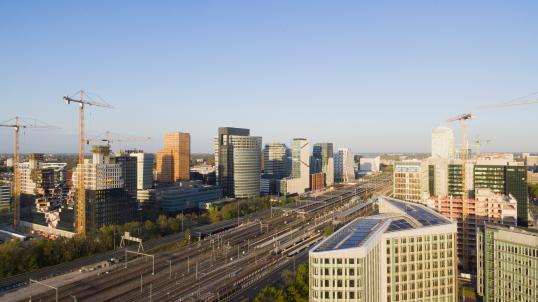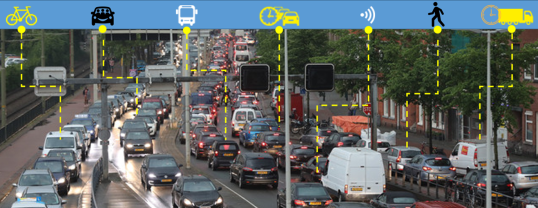- Topic
- Mobility management
- Country
- Netherlands
- Resource type
- Case study
First published on 21 June 2021.
The Metropolitan Region Amsterdam (MRA) is growing. By 2040, there will be an additional 250,000 homes and many more jobs. With this growth, mobility will also grow. However, the roads and public transport system had already almost reached their limits before the coronavirus (COVID-19) outbreak. Although the full impact of COVID-19 on urban mobility in the coming years remains uncertain, one could expect mobility to grow again. Hence, how to keep the MRA accessible in a sustainable manner continues to be a challenge. Within the MRA, it is not just the urban authorities that face this challenge and are looking for solutions to improve access and ensure sustainable mobility. Increasingly, employers are also looking at how to improve the mobility that is related to their business and their employees.
Context
Almost a third of journeys in MRA start or end at the workplace. Most of these journeys are made within a few hours each day (that is, the morning and evening rush hours). The number of trips to workplaces has been growing over the past decade and further growth is expected. However, during the COVID-19 pandemic, work-related mobility has reduced. While the distance of the average commute in the MRA is shorter than the national average, the average commute in the MRA takes longer. Vehicle users in the MRA spend some 60 hours per year in traffic jams. Infrastructure works across the urban area have been, and will continue to be, the cause of additional temporary bottlenecks in parts of the area.
A network of employers in the MRA is working with the urban authorities to keep the area accessible for their businesses and employees, while promoting sustainable mobility. Safeguarding good accessibility is important for many businesses. At the same time, employers are increasingly concerned about the sustainability of their operations, including transport. There is also increasing attention being paid to promoting the use of active modes of transport as part of strategies to support employee health and wellbeing.
In 2015, a network called Breikers was created by two business and industry interest groups to help employers in the MRA transition to smart and sustainable mobility and logistics. Today, it has grown into a network of more than 250 employers, which employ nearly 200,000 people. Breikers supports and advises employers in finding efficient and sustainable transport solutions. It also cooperates with the urban authorities in various initiatives to reduce congestion and promote smart and sustainable mobility.
In action
To better manage workplace-related mobility, an ‘employer-focused approach’ has been developed. This involves bringing together and inspiring employers in a specific area and helping them to change and manage their mobility. The approach includes:
- supporting and encouraging employers to shift towards smart and sustainable mobility and logistics, as well as flexible working;
- using employers to recruit participants to take part in incentive schemes to improve mobility management;
- connecting employers with each other and the public authorities to enable them to learn from each other and to work together.
The Breikers network is a non-profit organisation, receiving financial support from the Government-funded programme Building Accessibility Together(link is external). Services are provided free of charge to employers. The network provides employers with tailor-made advice from experts in the field of mobility and behavioural change. A wide variety of measures exist that can improve mobility management. Expert advice is provided on mobility options and incentives that can be used by employers to change mobility patterns. Measures covered include a range of Mobility as a Service (MaaS ) solutions, company car schemes, a rideshare app, (e)bike leasing, parking policies, mobility budgets for employees, carbon dioxide (CO2) pricing/budgets for employees, flexible working hours, promoting working from home and reward schemes.
Advice is also provided on wider measures, such as subsidies and financing schemes, regulations, tax implications and practical issues involved with the implementation of the mobility management measures. Furthermore, employers can get advice on how to prepare for anticipated changes in regulations (for example, how to prepare for the situation from 2025 when only zero emission vehicles will be allowed for urban logistics inside the A10 ring road). Employers can receive information and advice on such things as ways to optimise logistics, how to use and/or invest in zero-emission vehicles, how to access electric charging infrastructure, financing schemes, the use of logistic hubs and regulations.
In addition, Breikers provides companies with a dashboard that enables them to analyse and monitor their mobility. It also offers employers an online platform where they can share knowledge and experience. The network focuses on supporting the replication and scaling up of concrete, proven solutions, and brings together supply and demand sides of sustainable mobility.
Employers throughout the MRA can request support from Breikers, which includes specific help for employers and their workers affected by large-scale infrastructure works. One example is Amsterdam Zuidas, an area once dominated by office buildings, which is being developed into a new city district where thousands of people will live, work and enjoy recreational activities. Given the extent of the construction activities for the many developments in this area, it is inevitable that accessibility will be affected. Residents and visitors will be inconvenienced by the construction work, diversions and construction traffic. At the same time, a range of mobility options and services exists and these are likely to further develop and improve in the future. Clear and accessible information on these options for flexible, efficient and sustainable travel helps employers and commuters adapt to temporary accessibility problems, and can drive more permanent changes in mobility patterns.
Results
Since the start of Breikers in 2015, more than 250 employers have joined and have received advice and support. The support measures have resulted in a reduction of more than 12,000 journeys during peak hours and over 180,000 kilometres of passenger car use, and have saved over 30 tonnes of CO2 emissions each day.
The extent of the changes in mobility at a particular company depends on its objectives. Reasons for companies seeking advice from Breikers range from increasing sustainability and promoting wellbeing to reducing costs. Problems with accessibility due to infrastructure works or an office relocation are also reasons for employers to think about mobility and to participate in the network. The advice employers receive is tailored to their objectives. This shows which actions an employer can take and what the impact is on transport facilities (for example, CO2 emissions) or the wellbeing of employees. Experience has shown that employers are often surprised to see what options are available.
Actions that are particularly effective in changing mobility structurally include reducing parking opportunities (or increasing tariffs), adjusting travel allowances and promoting flexible working. Examples of the latter include having flexible start and finish times or working from home. However, the successful introduction of these measures is often combined with the introduction of other measures (such as a reduction in the number of parking spaces in combination with the opportunity to use MaaS).
While incentive schemes can work well to produce short-term results, structural changes do not come overnight. Experience shows that, on average, it takes 2 to 3 years before employers have fully implemented their new mobility policies and for workers to have fully adjusted to these.
Challenges, opportunities and transferability
Employers can make a useful contribution in changing mobility habits related to their organisation. With more employers participating, the impact increases – especially if larger organisations participate. Building a network of employers based on an area-oriented approach can help to increase effectiveness, as stakeholders with a shared interest in improving sustainable mobility within the same geographical area are connected with each other. It can also help in combining knowledge and creating momentum and ideas, as well as in achieving the necessary scale for opportunities to implement mobility solutions. Companies and organisations are also looking at each other for successful examples of how to promote sustainability or wellbeing and how to shape their mobility policies.
The approach can be easily transferred to other cities and their functional urban areas. In several Dutch cities, support and collaboration platforms have been developed for mobility management and promoting sustainable mobility related to work. A national platform has also been created where regional networks are able to exchange good practice and increase the visibility of mobility solutions and campaigns for flexible working. By providing relevant tools and tips, it helps employer organisations to better facilitate flexible working, and smart and sustainable travel for their employees.
The size of the areas targeted by an employer-focused approach varies. Typically, they cover the functional urban area of a large city, such as Amsterdam, but they could also focus on areas within that system. The approaches can co-exist with services targeting the functional urban area or smaller particular areas.
‘Disruptive events’ provide excellent opportunities to promote changes in work-related mobility. This is because employers and employees are more willing to consider alternatives to their current mobility when exposed to disruptive events. Examples of such events include moving to a new location or large-scale infrastructure works that hamper accessibility. The introduction of low (or zero) emission zones is another example of such an event – as is the COVID-19 crisis. These are times when people reconsider their travel behaviour, so the events offer opportunities for the effective use of a network of employers.
The approach is also most effective when it is demand driven, so responding to a clear request from an organisation to help change its mobility pattern, rather than using an employer-focused approach to ‘push’ participation in temporary mobility campaigns and incentive projects. The tailor-made advice that organisations receive is crucial in achieving change in the mobility related to these organisations. This includes informing employers about mobility solutions that are available and appropriate for them, and how to implement the measures in practice. In many organisations, human resource managers are responsible for the policies on commuting. However, they often lack the time and/or detailed knowledge that will enable them to explore and implement options for sustainable mobility management. Receiving free and independent practical advice on how work-related mobility can be managed and implemented within an organisation can provide the ‘push’ some might need to start to manage their mobility more efficiently, more sustainably and/or more healthily. With the support employers receive, changes in mobility can be established more effectively. Through the network approach, every change that is made provides another example for other employers and a contribution towards more sustainable mobility management.
In Depth
See also the expansion of smart bike parking tags being used in Amsterdam here.
Photo Credits: Ecorys and © Claire Slingerland/ Shutterstock.com - no permission to re-use image(s) without separate licence from Shutterstock.


